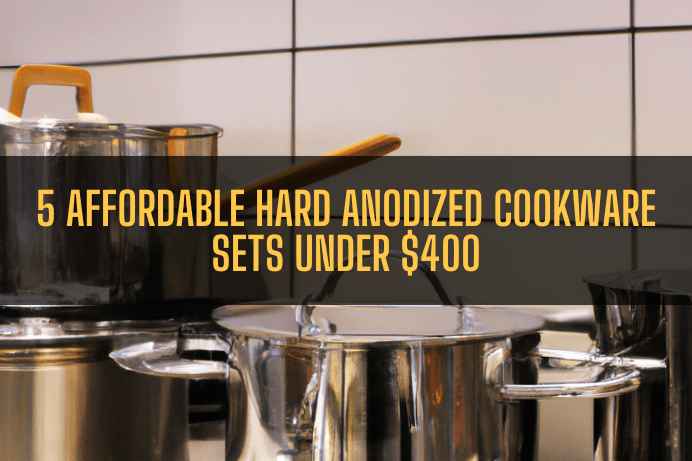How To Clean Hard Anodized Cookware After Baking? 5 Proven Methods Of Cleaning
Are you struggling to remove those stubborn stains and baked-on food residue from your hard anodized cookware?
It can be frustrating to spend hours scrubbing only to have your pots and pans still look dirty. But fear not! With the right techniques and tools, you can easily clean your hard anodized cookware and make it look as good as new. Here are five proven methods for how to clean hard anodized cookware after baking.
Soaking a pan in hot water and liquid dishwashing soap like Dawn® is the best way to remove burnt-on grease from hard-anodized aluminium. Scrub with a heavy-duty scrub sponge and then hand wash using water and a specific hard anodized cleanser like Bar Keeper’s Friend®.
In this blog post, we’ll share some tips and tricks for cleaning hard anodized cookware after baking. So, let’s get started and make your cookware shine again!
5 Proven Methods to To Clean Hard Anodized Cookware After Baking
Removing burnt-on grease from hard anodized cookware can be daunting, but it is not impossible.
The following are the best tactics for the people of USA or elsewhere to clean your hard anodized cookware after baking:
Baking Soda And Water; A Magical Formula

One effective method is to use a mixture of baking soda and water.
- As a first step, liberally apply baking soda to the sticking point.
- Next, to make a paste, add a little water.
- Let the paste sit on the cookware for about 10-15 minutes.
- Next, use a non-abrasive sponge or scrubber to scrub the cookware gently.
- Drain the water and pat dry with a clean towel.
Vinegar And Dish Soap
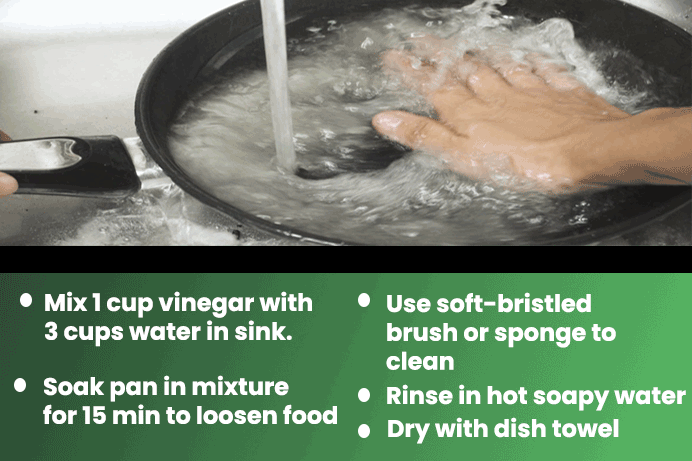
The vinegar is the secret to the success of this strategy. Because of its acidic nature, vinegar effectively removes burnt-on residue, food particles, and stains.
White vinegar, water, dish soap, and a sponge are all you need to get the job done.
Follow these steps:
- Put one cup of vinegar into three cups of water to fill a sink. Put the entire pan under water.
- Let the dish soak for 15 minutes. The bits of food will become loose.
- Loosen the particles of food with a soft-bristled brush or sponge.
- Put it back in some hot soapy water.
- You can use a non-abrasive sponge, a soft bristles brush, or a washcloth to clean the pan.
- Whatever residue is left will eventually wash away.
- Use a dish towel to dry.
Cookware Cleaners
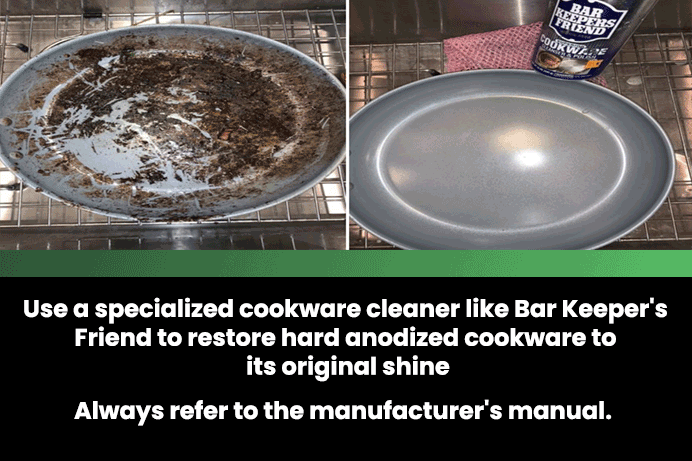
- Another option is using a specialized cookware cleaner like Bar Keeper’s Friend, designed for hard anodized cookware.
- Always refer to the manual provided by the manufacturer.
- Hard anodized cookware can be restored to its original brilliance with time and effort spent removing burned-on oil.
Cream Of Tartar
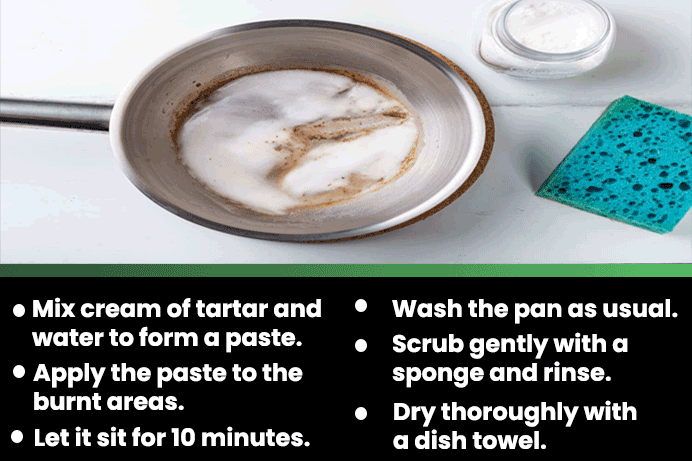
It is a fantastic strategy for eliminating external and inner grease stains from your pan. Because the cream of tartar is acidic, it effectively removes grease, filth, and smells. You may clean your dishes using just a few tablespoons of cream of tartar, some hot water, a sponge, and a dish towel.
Follow these steps;
- Combine cream of tartar and water in a bowl to form a paste.
- Spread the paste over the burnt sections of the pot. Alternatively, you can spread it all over the baking dish.
- Rest it for ten minutes
- Use a gentle sponge to scrub the paste; remove it gently.
- When you’ve finished, use your preferred method for washing the pan.
- Use a dish towel to dry off all.
Lemon and salt
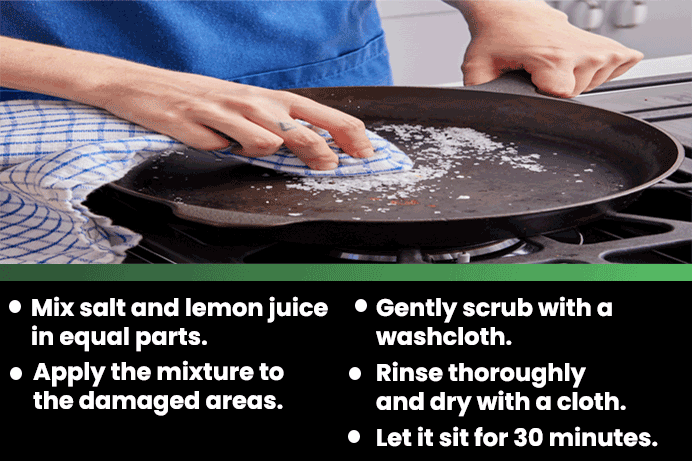
Lemon is a natural disinfectant, and salt is abrasive, so the two work well together. There is no match for this method to remove stains, burns, and discolouration on the inside and outside of your pan.
Follow these simple steps:
- Mix salt and lemon juice in a 1:1 ratio to adequately cover the damaged sections.
- Spread the mixture gently over the damaged areas.
- Rest it for about 30 minutes before using it.
- Use a washcloth as a scrubber.
- Be careful, as the salt could ruin the pan’s finish if you’re not careful.
- Please give it a good rinse and pat dry.
How To Clean The Burnt Bottom Of A Hard Anodized Pan After Baking?
If your Calphalon cookware has a stained and splotchy bottom despite your best efforts, there is still hope.
The Calphalon Dormond Hard-Anodized Cookware Cleaner and Polish is specifically designed for Calphalon hard-anodized cookware and effectively removes stubborn stains and burnt-on food. It is also useful for bringing back the shine of dull cookware. Carefully adhere to the guidelines provided by the manufacturer.
Using this product, you can effectively clean the bottom of your Calphalon hard anodized pan and keep it looking and functioning at its best.
What mistakes to avoid while cleaning hard anodized cookware after baking?
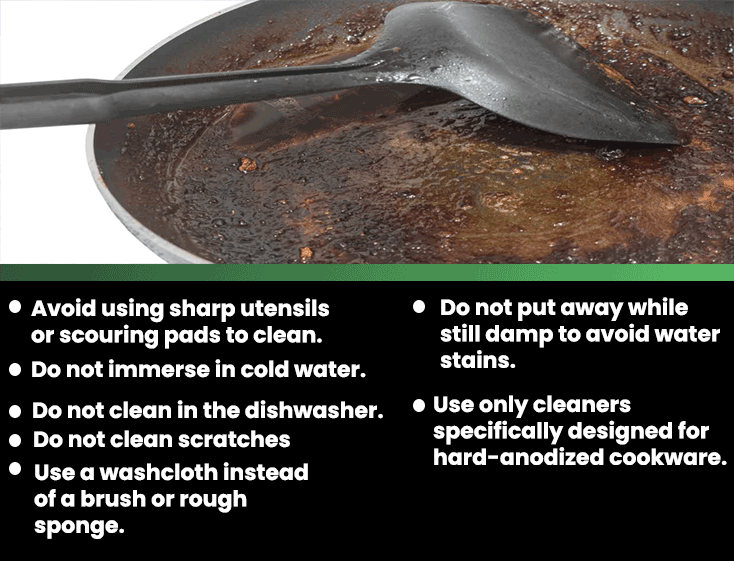
- No matter how stubborn the food is, never use metal utensils, scouring pads, or other sharp implements to clean your hard-anodized cookware. Immersing hard anodized cookware in cold water may result in wrapping the cookware.
- Don’t clean your scratches and surface damage.
- Do not clean Calphalon hard-anodized in the dishwasher.
- Use a washcloth instead of a brush or rough sponge if you don’t have either.
- Never put away the pots and pans while they’re still damp. It may leave water stains.
- Avoid alkaline-based cleaners+. Always use the right cleaner specifically manufactured to clean hard anodized cookware.
How do you clean burnt, hard-anodized pans?
Please put them in a sink full of hot soapy water (when the pan has cooled), clean them with a cloth, soft bristles brush, or non-abrasive sponge, and finally, dry them with a dish towel. Try one of the other strategies described here if it doesn’t work.
Is this white film on my hard anodized pan normal?
Hard water stains and residue from naturally occurring culinary items like butter and oil are likely to blame. Avoid this by always giving your pan good washing and drying after use.
Can I scrape food bits off my hard-anodized pan with metal utensils?
No. Never, ever do this. Even a single scratch can damage the pan. Only use nylon or wooden utensils.
How do I get rid of sticky grease from the cooking surface?
Combine baking soda, lemon juice, and warm water to create a cleaning solution. The baking soda needs a few minutes to do its thing and remove the grime by scrubbing it with a sponge.
Conclusion
With the correct equipment and methods, hard anodized cookware can be cleaned thoroughly after use in the oven. Scrubbing or cleaning with harsh chemicals could scratch the surface of your cookware, so please don’t use them. Instead, opt for gentle, non-abrasive methods like soaking with baking soda or specialized cleaning solutions designed for hard anodized surfaces. Patience and attention to detail allow you to keep your hard anodized cookware looking clean and shiny for years.





